Chord progressions are integral to creating the mood and tone of a song.
Hence, when crafting a love song, the choice of chords becomes even more vital.
This piece offers insightful tips and explores a variety of chord sequences that can paint the perfect sonic picture of romance and devotion.
Through the right mix, you can evoke whatever kind of love narrative from joyful to longing, passionate to serene.
So, if you’re an aspiring songwriter, a seasoned artist, or a music lover, this blog could be instrumental to your creative process.
Let us delve into the wonderful world of chord progressions and their magic in shaping love songs.
Table of Contents
- Romantic Chord Progressions
- I-V-vi-IV (1-5-6-4)
- I-vi-IV-V (1-6-4-5)
- I-IV-V-IV (1-4-5-4)
- ii-V-I (2-5-1)
- I-IV-ii-V (1-4-2-5)
- vi-IV-I-V (6-4-1-5)
- IV-V-iii-vi-ii (4-5-3-6-2)
- I-vi-ii-V (1-6-2-5)
- ii-vi-IV-I (2-6-4-1)
- IV-ii-vi-I (4-2-6-1)
- I-IV-vi-V (1-4-6-5)
- ii-IV-I-V (2-4-1-5)
- IV-I-IV-V (4-1-4-5)
- I-ii-IV-V (1-2-4-5)
- vi-ii-IV-V (6-2-4-5)
- IV-vi-V-I (4-6-5-1)
- I-IV-I-V (1-4-1-5)
- The Bottom Line
Romantic Chord Progressions
I-V-vi-IV (1-5-6-4)
Incredibly versatile, creating both uplifting and heart-wrenching romantic atmospheres.
The I-V-vi-IV chord progression, also known as the “pop-punk” progression, has been widely utilized in numerous genres because of its heartfelt, sentimental tune that tends to evoke profound emotions. It starts with a sturdy, confident base, experiences a dramatic shift, and then descends to a more melancholic tone, often used to convey deep feelings or an emotional narrative in a love song.
- Difficulty: Easy
- Example: C – G – Am – F (Key of C major)
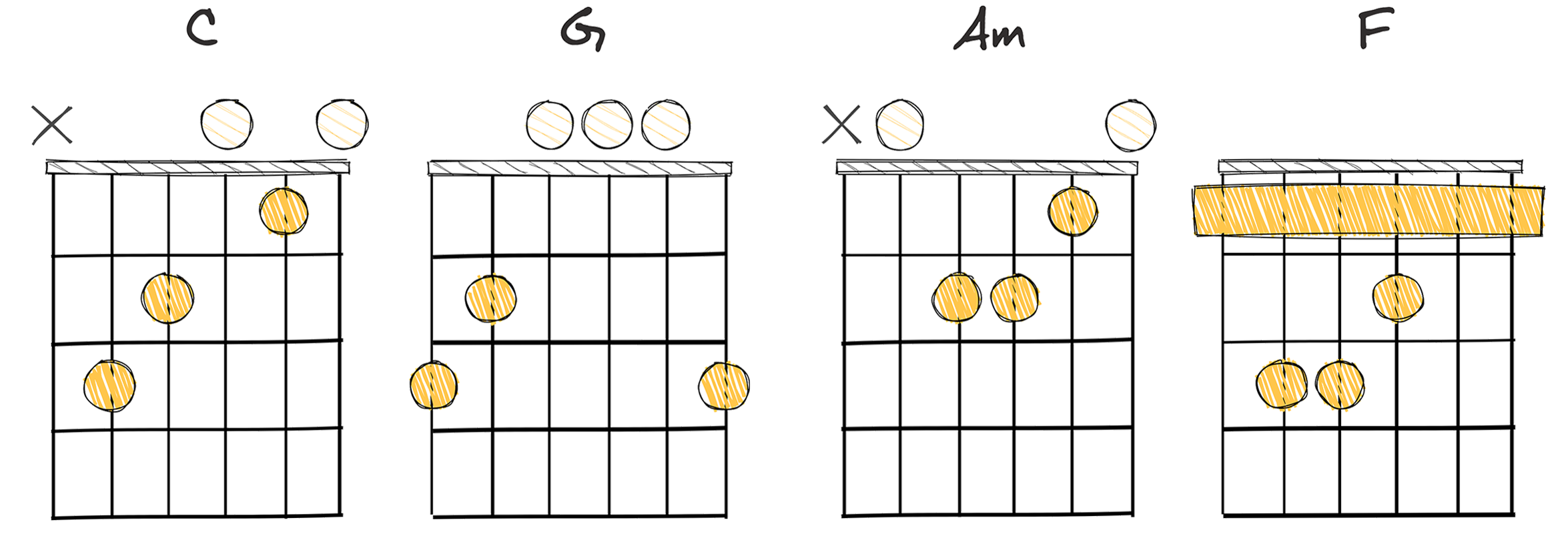
Starting off our deep dive into romantic chord progressions, we’ll first tackle the I-V-vi-IV progression.
This magical sequence is nothing short of remarkable, lending itself beautifully to the creation of heartfelt, soul-stirring love songs.
One of the most significant aspects of the I-V-vi-IV progression is its historical context.
This progression has been a favored cornerstone of music for centuries, often relied upon to convey deep and profound feelings of love and passion.
The history of this progression is, as such, deeply entwined with the history of love in music.
The I-V-vi-IV progression is not just a sequence of chords but a storyteller – a melodious narrator of love stories across generations and genres.
Alluding to the above quote, the progression is a universally understood language in the music realm.
It is not a mere set of chords but rather a musical structure that lays the foundation of beautiful love stories through captivating tunes.
The impact that these four chords can have on a listener when harmoniously played is astounding.
Adding to its allure, the I-V-vi-IV progression is incredibly easy to play, making it a perfect choice for budding musicians wanting to express their budding romantic sentiments.
Its ease of execution paired with the feelings it can evoke makes it that much more accessible and appealing to musicians of all levels.
The chords in this progression, when transcribed to the Key of C Major for example, would see us play C – G – Am – F.
A beautifully moving combination, the sequence of these chords stir the senses and captures the essence of romantic musings.
One can’t help but sing along when the sequence of chords ring out in a love song, tugging at heartstrings and evoking emotions and memories synonymous with love and passion.
This progression unites musicians and listeners in a collective understanding of love’s gentle tug and potent emotionality.
It is testament to its timeless value and the significant role it has in creating love songs.
Thus, the effectiveness of the I-V-vi-IV progression in creating impactful love songs cannot be underestimated.
It bears a fundamental role in the enchanting world of Love’s musical expression, binding minds and hearts together in a shared rhythm of sentimentality.
To fully appreciate the beauty and power of this progression, one should simply sit back, listen, and allow the chords to tell their timeless tale of romance and affection.
After all, the chords themselves form the romantic anthology that serenades the hearts of lovers worldwide.
If one is searching for a way to effectively convey deep feelings of love and passion through music, the I-V-vi-IV progression is undoubtedly a go-to choice.
From historical relevance to aural magnificence, the progression holds all the magic needed to create a timeless love song.
I-vi-IV-V (1-6-4-5)
A timeless progression, encapsulating the sweet waxing and waning of love.
The I-vi-IV-V chord progression, also known as the ’50s progression, is a popular sequence that offers a sentimental and romantic mood perfect for love songs. These classic quartets of chords create a soft, melodic structure that enhances the emotional depth of the lyrics and melody, evoking feelings of nostalgia and romance.
- Difficulty: Easy
- Example: E – C#m – A – B (Key of E major)
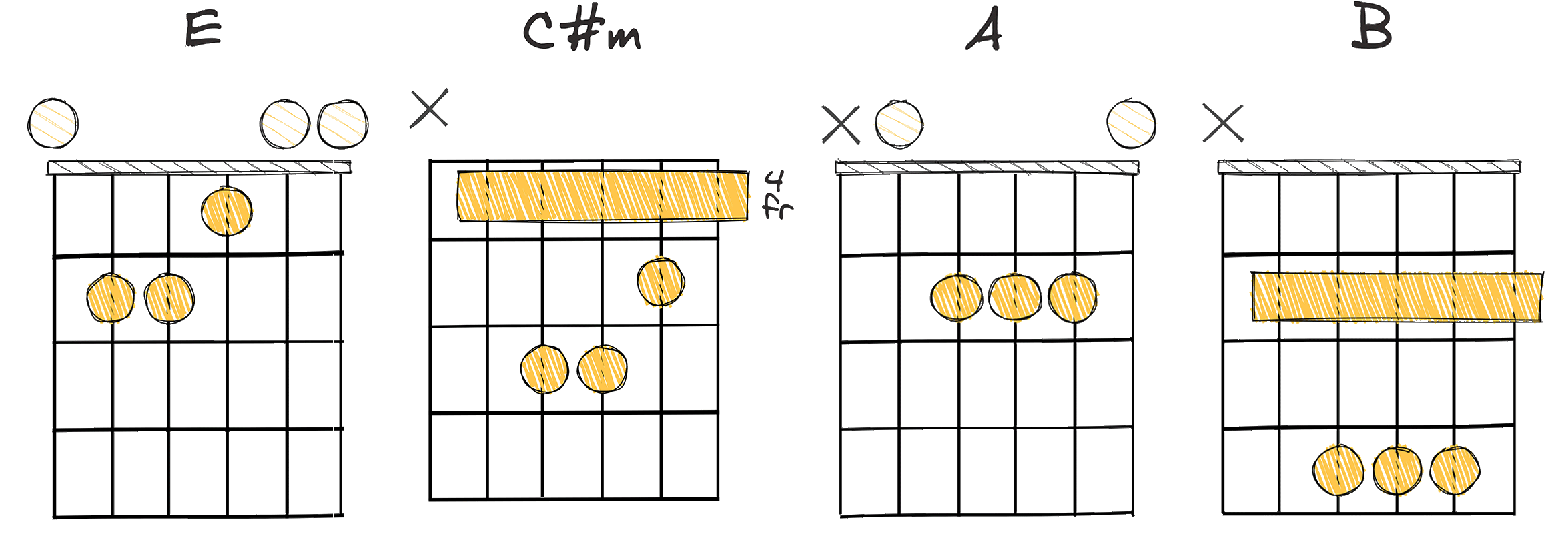
The I-vi-IV-V chord progression is not only the basis for countless love songs over the years, it is also one of the easiest progressions to play.
By simply moving from the I to the vi, then to the IV and finally to the V chord, budding musicians can create a lush romantic soundtrack that speaks directly to the heart.
The origin of this chord progression can be traced back to the classical music era, from which it was borrowed by RnB, pop, rock, and country musicians to write some of the most enduring love songs in music history.
The shift from the vi chord to the IV chord (A) then introduces a new level of lightheartedness or optimism into the mix, suggesting that all hope is not lost.
As for the final V chord (B), it provides a natural resolution to the IV chord and works to build momentum, ushering in the return to the home I chord, and thus, the beginning of the progression’s next cycle.
According to music theory, moving from the vi chord to the IV chord creates what is called a “deceptive cadence“.
This unexpected chord change heightens emotional impact by both disrupting listener expectations and enriching the song’s harmonic contrast.
It’s also worth noting that the I-vi-IV-V progression allows for a lot of flexibility when it comes to melody writing, which is why it’s such a popular choice for songwriters looking to convey the complex emotions associated with love.
No doubt, the combination of its simplicity, emotional depth and malleability makes the I-vi-IV-V chord progression an ideal choice for love songs.
Moreover, its universal nature means it can be adapted to suit various music styles, from RnB and pop to country and rock.
From seasoned musicians to beginner guitarists, this progression offers the perfect starting point for anyone aiming to create a beautiful love song.
Even after decades of use, the I-vi-IV-V chord progression has yet to lose its magic.
Its enduring appeal is a testament to its power to stir emotions and create memorable musical moments.
So whether you’re penning a serenade for your special someone or simply looking to express common human emotions, the I-vi-IV-V progression is definitely one to consider as it forms the backbone of some of the greatest love songs ever written.
It is proof that sometimes, the simplest things can create the most profound impacts.
If done right, the I-vi-IV-V chord progression can give rise to a perfect love song, one that can withstand the test of time and continue to express the ever-evolving nuances of love.
I-IV-V-IV (1-4-5-4)
A harmonious progression evoking feelings of love and nostalgia.
The I-IV-V-IV chord progression exudes a romantic and nostalgic feel, often utilized in love songs due to its cyclical, emotive nature. The transition from the 4th to the 1st to the 5th chord and back to the 4th creates an emotional journey, captivating listeners and invoking feelings of romance.
- Difficulty: Easy
- Example: F – Bb – C – Bb (Key of F major)
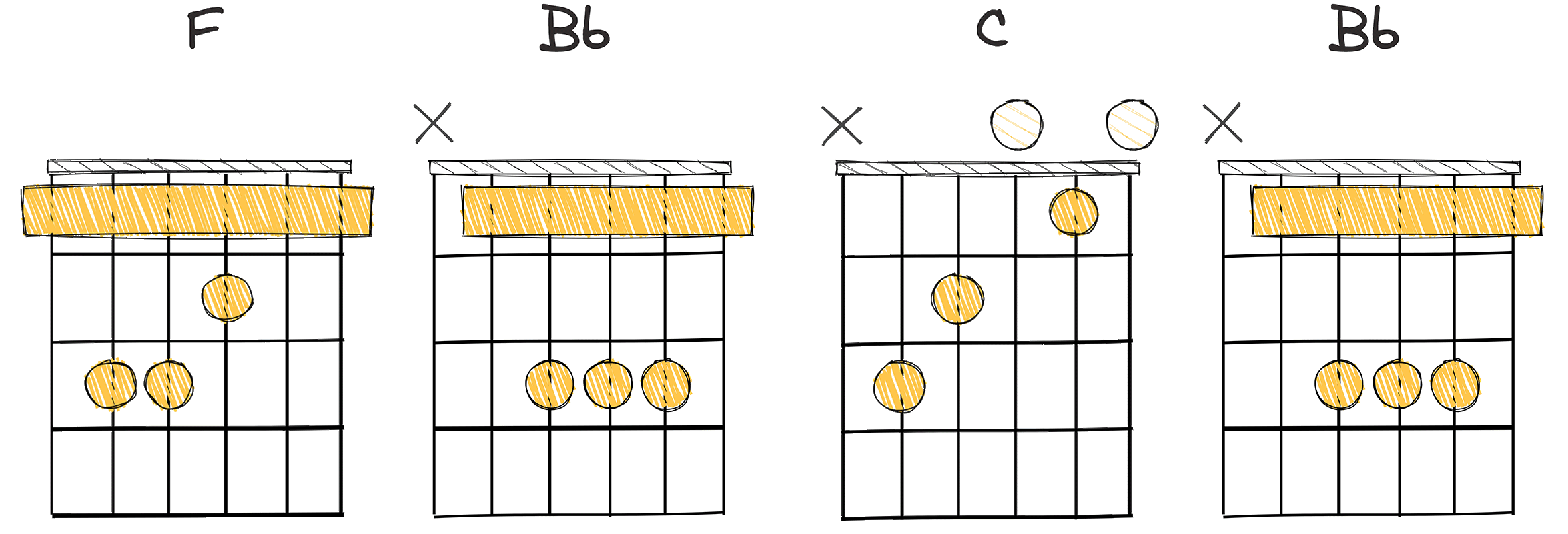
In the evolution of music, different chord progressions have been developed, some of which have come to be associated with certain moods or themes.
One key progression that has gained a reputation for conjuring up feelings of love and romance is the I-IV-V-IV (1-4-5-4) progression.
But what makes this chord progression so potent in evoking these tender emotions?
To understand this, let’s look at its very composition.
The starting point is the IV chord, which immediately sets a positive, uplifting mood.
Then, we swiftly move to the I chord, which serves as the tonal center and the anchor point of the progression, thereby creating a feeling of unity and stability.
It’s this seamless transition between the IV and I chords that forms the simple yet powerful foundation upon which the entire progression rests.
This fulcrum of the progression is the primary reason why it’s easy to play, even for those with minimal experience with a musical instrument.
Following this, we have the V chord, which adds a sense of tension and anticipation to the progression.
Finally, this tension is released as we loop back to IV chord, taking the listener on a cyclical journey that’s analogous to the ups and downs of a romantic relationship.
The simplicity and universality of this progression mean that you can find it in a multitude of songs spanning across various genres and eras.
This testament is showing how incredibly versatile this progression is and how it can be adapted to various different musical contexts.
So the next time you’re trying to convey feelings of love and romance in your music, don’t forget about the power of the IV-I-V-IV progression.
And given its robustness and flexibility, this progression will likely remain a staple in romantic music for years to come.
ii-V-I (2-5-1)
The secret sauce to crafting a timeless love ballad.
The ii-V-I (2-5-1) chord progression is a beloved sequence in the world of music, offering a sense of homecoming and resolution that can evoke strong emotions. It’s frequently used in love songs and ballads, providing a romantic backdrop that can tug at the heartstrings of listeners.
- Difficulty: Intermediate
- Example: Dm – G – C (Key of C major)
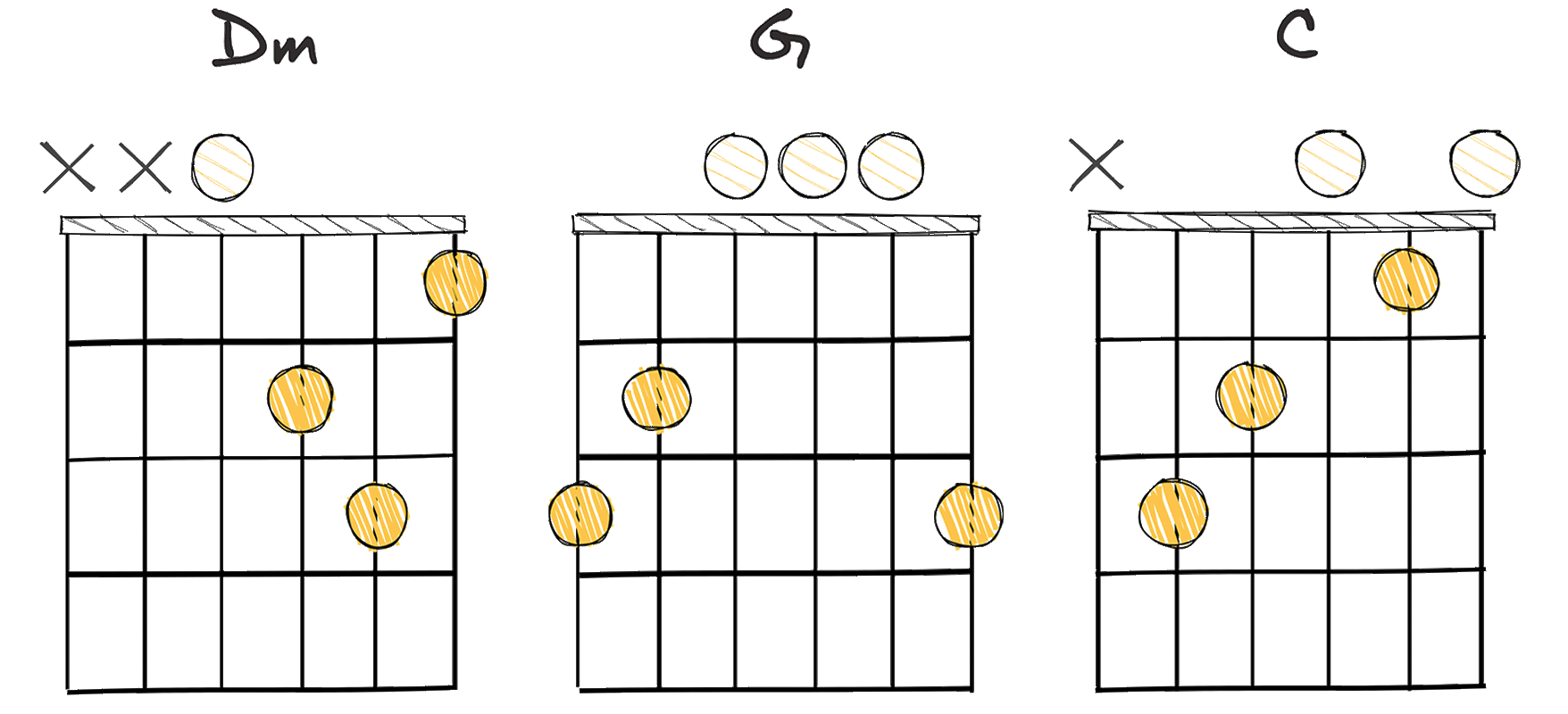
Exploring the chord progression of ii-V-I (2-5-1), one can uncover an essential musical formula often used to evoke romantic sensations in a love song.
The ii-V-I progression can be considered as the backbone of much Western music, most notably in the realm of jazz and popular music styles.
Delving back in history, the ii-V-I progression was prevalent in the Baroque period, made popular by composers like Bach.
The ii in this progression is the ‘subdominant minor’ chord, introduces tension which is pleasingly resolved by the dominant, or V chord.
This is followed suit in a satisfying resolution to the I chord, or the ‘tonic’ of the key.
By fluctuating between these three chords, ii-V-I creates an alluring cycle of tension and resolution.
Each time a musician cycles through a ii-V-I progression, they build up tension and then provide relief, creating a dramatic and emotional landscape that’s perfect for a romantic love song.
This progression is a delight for listeners, providing an instinctual sense of direction, which underpins the deep emotional appeal of many love songs.
When playing, this progression does require some intermediate level of skill, as it involves a transition through various chord shapes and positions efficiently.
Therefore, it’s an excellent progression to master for all aspiring songwriters or instrumentalists wanting to explore the sentimental qualities of love ballads.
The progression lends itself well to the song’s lyrical content, expressing sentiments of emotional vulnerability, yearning, and love.
If we’re talking about the roman numerals with no indicated chords, one can assume that the chords played in a ii-V-I progression can be based on a D minor (Dm) chord as the ii, G major (G) as the V, and C major (C) as the I in the key of C major.
I-IV-ii-V (1-4-2-5)
This harmonious blend creates absolute musical poetry for romantic ballads.
This chord progression, I-IV-ii-V, often used in romantic ballads, lends itself to a light, uplifting feel that’s ideal for setting a love-stricken or dreamy mood. Utilizing the 1st, 4th, 2nd, and 5th chords from a given key, this progression culminates in a resolving tone, delivering a sense of soothing completion that parallels the feeling of a comforting, happy ending love story.
- Difficulty: Easy
- Example: D – G – Em – A (Key of D major)
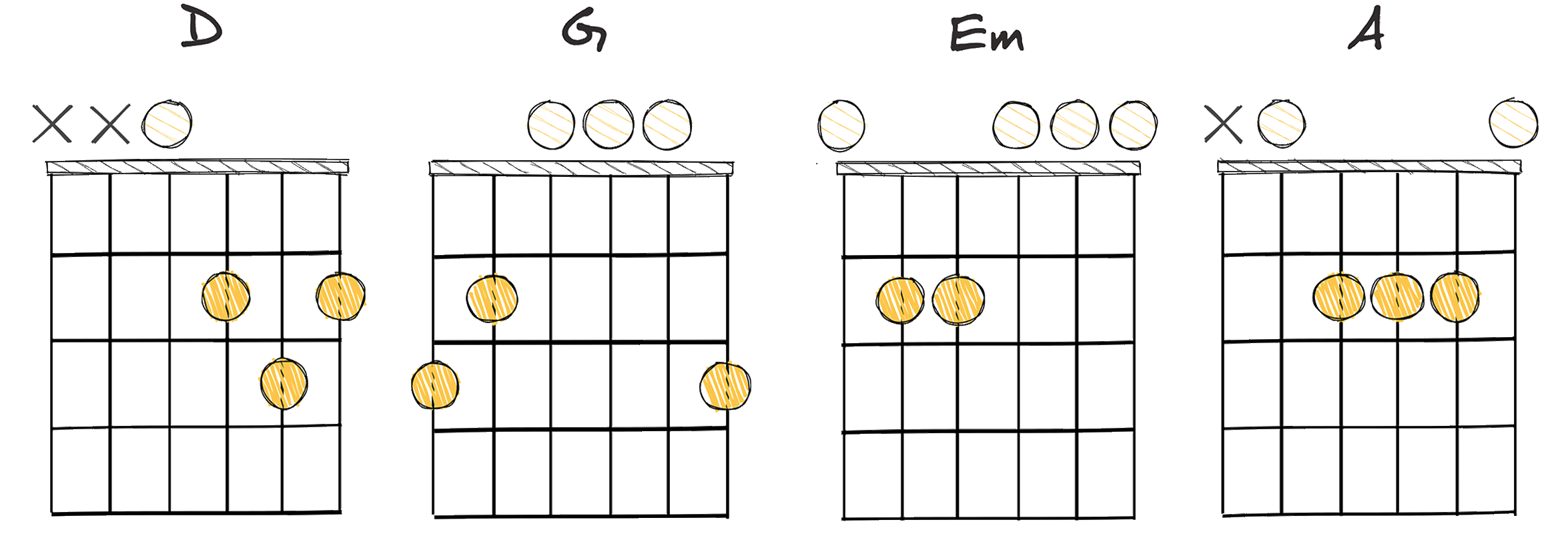
When creating a romantic piece in music, one richly rewarding approach is through the use of the I-IV-ii-V (1-4-2-5) chord progression.
This musical sequence is incredibly versatile, often used in different music genres to stir emotions, particularly those related to love.
In the realm of Western music, I-IV-ii-V has a long-standing tradition that reaches back centuries.
This progression provided the backbone for baroque, classical, and romantic music, among many other styles, eventually becoming a staple in modern music composition.
By today’s standards, one might even suggest the I-IV-ii-V progression is an ‘easy-to-play’ backbone for hit love songs.
Perhaps the significance of the I-IV-ii-V progression stems from its ability to evoke a wide range of human emotions, particularly those tied to love and romance.
Moreover, transitioning from the tonic chord (I), to the subdominant (IV), then to a minor supertonic (ii), and finally resolving on the dominant chord (V), this sequence allows for a playfulness that appeals to our senses.
Transitioning between these chords creates a natural tension and release, which mirrors the ups, downs, and resolves found in romance.
This interplay can turn an ordinary song into an impassioned ballad, a musical embodiment of the ebbs, flows, and crescendos in romantic interactions.
The I-IV-ii-V progression’s enduring popularity is also seen in today’s contemporary music.
Many modern musicians look back to this traditional, steadfast progression when they seek to incorporate a tint of romance into their works.
In sum, the I-IV-ii-V chord progression remains a powerful tool for composers and musicians.
Its ability to reflect the complexities of emotion, particularly those residing in the realm of love, has helped it stay relevant and resonant for many generations.
vi-IV-I-V (6-4-1-5)
This progression embodies a melancholic longing, a staple in love songs.
The vi-IV-I-V chord progression is a popular sequence in romantic music, often used to evoke deep emotions and feelings of love. The progression begins with the vi chord, providing a melancholic touch, before transitioning through the soulful IV and I chords, and finally resolving with the uplifting V chord, lending an overall feeling of longing and resolution that often resonates with listeners and perfectly complements lyrics of love and romance.
- Difficulty: Easy
- Example: Am – F – C – G (Key of C major)
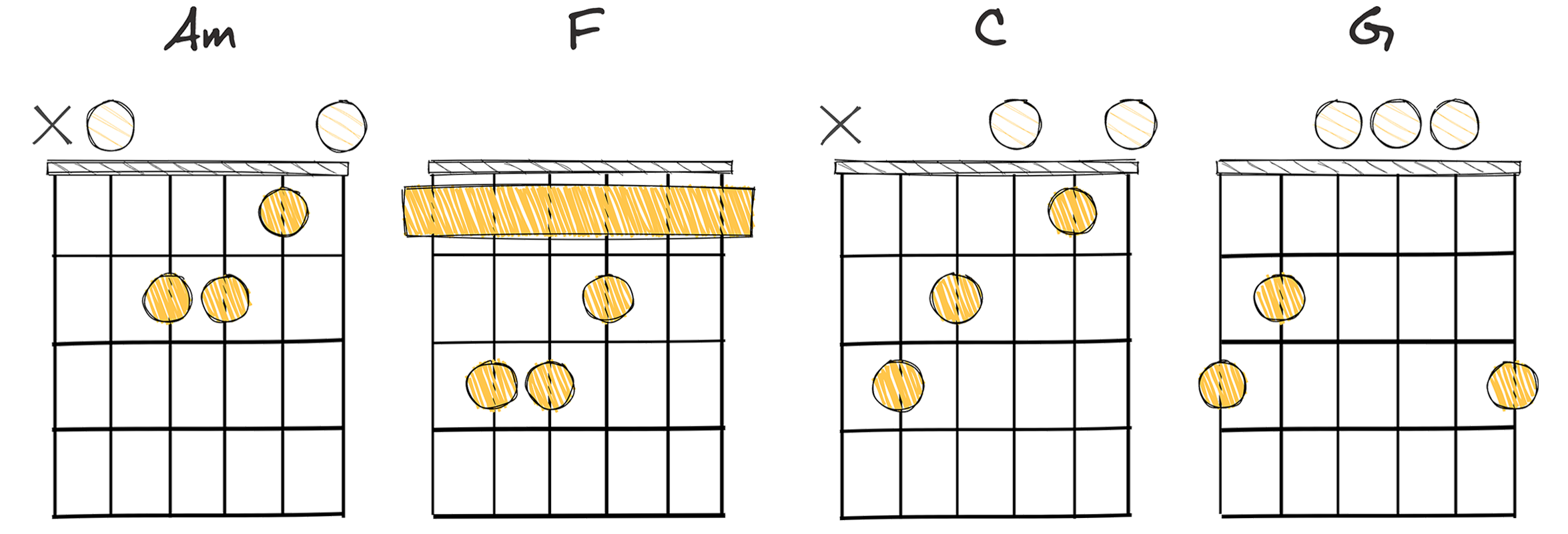
The vi-IV-I-V (6-4-1-5) chord progression is known for its sentimental and romantic tones, making it one of the most popular choices when crafting the perfect love song.
This progression, also known as the ’50s progression’ due to its popularity during that era, possesses a beautifully nostalgic tone which listeners find irresistible.
From a historical perspective, this progression has appealed to countless songwriters, as it provides a solid foundation upon which emotive and stirring melodies can be built.
Often employed by those in the business of songwriting, this progression’s simplicity offers an appealing ease-of-play.
The straightforward transitions from one chord to another provide an innate sense of cohesion and resolution, making it an ideal choice for songs focused on the theme of love.
As a result of these features, the vi-IV-I-V progression is both deeply satisfying to play and easy for listeners to connect with emotionally.
The chords used in this progression, Am – F – C – G, in the key of C major, have a warm, open quality to them that is a perfect fit for romantic ballads.
The building tension and release created by the chord movement provides the perfect dramatic underscore to Adele’s powerful narrative of love and heartbreak.
Furthermore, the accessibility of this progression makes it an excellent choice for beginners looking to learn how to play romantic songs on the guitar or piano.
Regardless of your skill level, the vi-IV-I-V progression offers the opportunity to create an emotionally charged, romantically inclined arrangement that speaks to the heart.
Consequently, should you wish to pen your own musical love letter, you might find the vi-IV-I-V progression to be an invaluable tool.
IV-V-iii-vi-ii (4-5-3-6-2)
A heart-tugging journey from longing to love’s fulfillment.
This chord progression, often found in romantic or love songs, creates a soft, mellow tone that captures the emotions of the lyrics effectively. The switch from major to minor chords in the IV-V-iii-vi-ii pattern adds depth and intensity, helping to evoke feelings of longing and affection, making it perfect for a love song.
- Difficulty: Intermediate
- Example: F – G – Em – Am – Dm (Key of F major)

In the diverse world of music composition, chord progressions serve as the cornerstone for creating captivating melodies.
The romantic chord progressions, specifically the IV-V-iii-vi-ii (4-5-3-6-2), offer a perfect blend of harmony and sentiment, thereby making them ideal for composing the perfect love song.
Historically, this progression, also termed as the 1654 progression, has its roots deeply embedded within romantic and contemporary music genres.
Over time, it has gradually evolved to become a staple for creating melodies that beautifully express complex human emotions.
Though this progression is intermediate in nature, its unique structure provides it with an irresistible charm.
It starts on the fourth degree (IV), journeys through the fifth (V), navigates to the third (iii) and then finally resolves to the sixth (vi), culminating in the second degree (ii).
The sequential progression from one chord to the other births a musical journey that beautifully encapsulates the essence of romance.
This quote highlights the progression’s significant use in creating an emotional narrative.
The transition through different chords creates a musical story, enabling a song to emotionally resonate with listeners.
The chords of F – G – Em – Am – Dm (Key of F major) are prime examples of this romantic progression.
These chords have been used extensively in pop music, seeing how they effectively convey deep sentiments.
This progression’s ability to maintain an optimal balance between repetition and variety is key to its widespread usage.
This balance helps in delivering a melody that is both familiar and intriguing to the ear.
In addition, due to its intermediate nature, musicians get a good leeway to innovate and experiment with their music while using this progression.
As a result, providing a palate for infinite creativity.
To sum up, the IV-V-iii-vi-ii progression’s enchanting capability to portray the myriad of emotions in love combined with its flexible nature truly makes it an appealing choice for composers aiming to pen down the perfect love song.
I-vi-ii-V (1-6-2-5)
A timeless chord progression drawing on the heartstrings of romance.
The I-vi-ii-V chord progression, commonly used in various genres, is especially popular in romantic ballads due to its smooth and emotional transition between chords. Known for creating a poignant and sentimental tone, this progression can establish an ideal atmosphere for a love song, evoking strong feelings and emotions.
- Difficulty: Easy
- Example: C – Am – Dm – G (Key of C major)
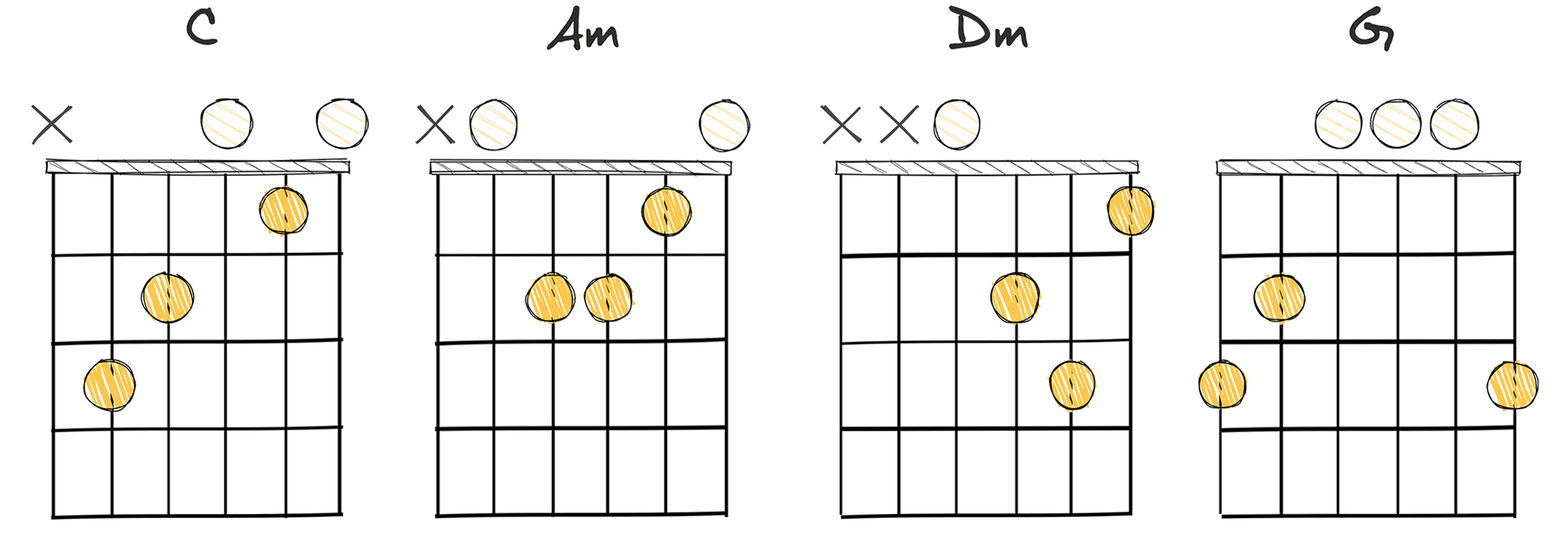
The chord progression I-vi-ii-V (1-6-2-5), is a common and versatile sequence, widely used in a myriad of musical genres, but especially prominent in romantic compositions.
Historically, this progression has been a popular choice among composers and songwriters due to its harmonic simplicity and fluid continuity.
The seamless flow from one chord to another aids in creating a soothing and emotive ambience, making it an ideal asset in sculpting a romantic soundscape.
Its simplicity has made the I-vi-ii-V progression a favorite among beginners, yet its ability to be manipulated and nuanced keeps it interesting for even seasoned musicians.
Indeed, this progression’s versatility is of interest.
It’s as much at home in a complex jazz standard as it is in a simple pop ballad, speaking to its flexible nature and broad applicability.
The I-vi-ii-V progression’s simplicity doesn’t just apply to its harmonic structure, but also to its playability.
Due to its utilisation of primarily basic chords, it is considered relatively easy to play on all instruments, making it an accessible entry point for those new to composition or playing.
This progression has been deployed effectively in romantic music to convey sentiments of longing, nostalgia, and of course, love.
It’s found in countless love ballads and romantic pop songs, its ever-repeating cycle evoking emotions of desire and passion.
In the key of C major, the I-vi-ii-V progression equates to C – Am – Dm – G.
Whether it’s a love song or a reflective ballad, the simplicity and versatility of the I-vi-ii-V progression makes it a staple in the romantic music genre.
Composers and songwriters still gravitate towards this progression, as its innate harmonic potential continues to inspire romantic compositions.
ii-vi-IV-I (2-6-4-1)
A heartfelt progression evoking deep emotions for a love ballad.
This progression is characterized by its tender and emotive tone, often found in romantic and heartfelt tracks. The ii-vi-IV-I sequence offers a gentle resolution, leading seamlessly from minor to major chords, making it ideal for creating the perfect love song.
- Difficulty: Easy
- Example: E – Bm – A – D (Key of D major)
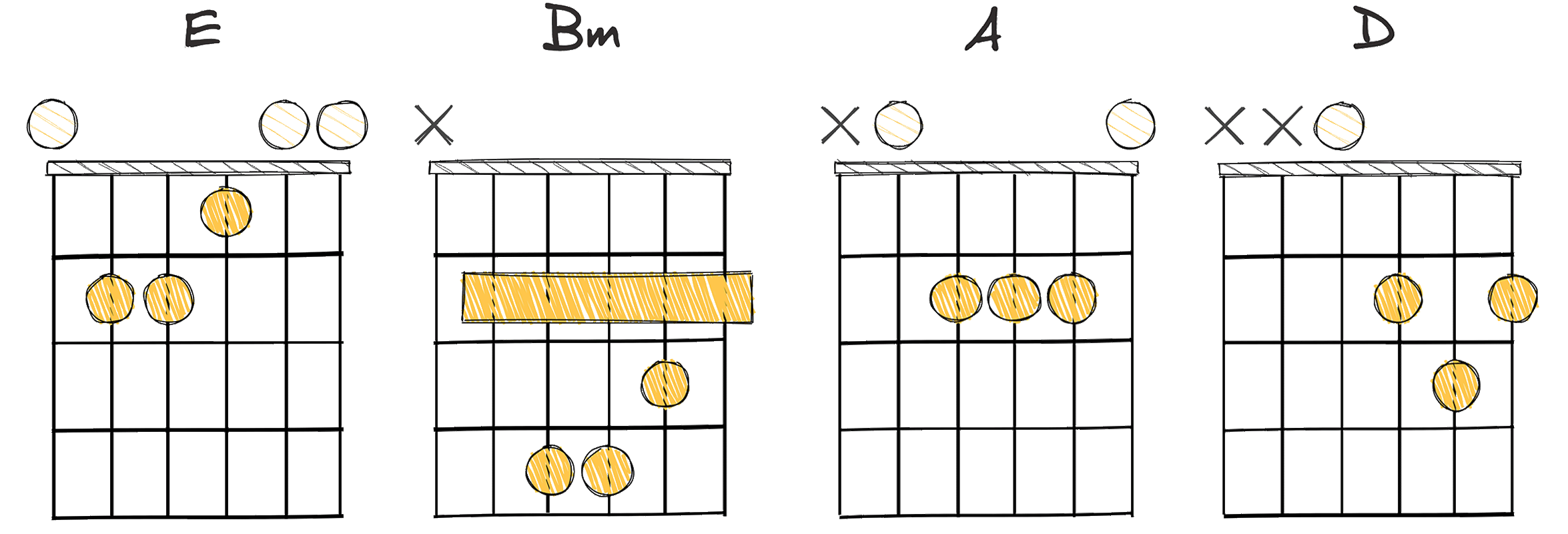
The chord progression ii-vi-IV-I (2-6-4-1) is an integral part of the process for composing enchanting melodies that evoke romantic feelings.
Its rich historical background embodies the potency of music as a language of emotions.
Originally rooted in classical music, this progression carries a long history of transcribing love and passion into harmonious form.
It is, therefore, not surprising that it has typified a great many love songs, and not merely those we consider ‘classical’.
This progression is characterized by its ability to seamlessly connect chords, smoothly transitioning between them in a way that is intuitive and sonically pleasing.
A direct consequence of this seamless connection is the remarkable possibility it provides for creating musical tension and release – a cherished feature in the construction of romantic narratives within music.
On another note, what makes this progression increasingly popular is its relative ease to play.
Being able to maneuver between the chords effortlessly allows for a greater focus on the emotional delivery, a fundamental ingredient when composing love songs.
Consider, for instance, E – Bm – A – D (Key of D major).
Even with minimal background in music theory, a novice musician can easily navigate this chord progression and produce beautiful, emotive sound.
Every chord in the progression serves a purpose, contributing individually and collectively to the overall romantic atmosphere.
The second degree chord (ii) introduces a sense of promise, the vi chord subtly infuses a level of melancholy, the fourth degree (IV) lifts the mood, and the tonic (I) concludes the progression with a sense of resolution – an emotional journey within each cycle.
Therefore, it is fascinating to observe the intricate dance between chords in this progression and how they aid in the articulation of love and romance within music.
This makes the ii-vi-IV-I progression an invaluable tool in the toolkit of any musician aiming to compose powerful love anthems, bearing in mind the simplistic yet complex narrative orchestrated by each chord in the series.
Furthermore, by studying and understanding this progression, we not only gain insight into one of the standard practices in music composition but also into the world of romantic music and how it manipulates sound to communicate the deepest aspects of human emotion.
IV-ii-vi-I (4-2-6-1)
This progression adds heartfelt sentiment, ideal for expressing deep affection.
This chord progression, IV-ii-vi-I, carries a beautiful romantic flow, often found in many love songs, and perfectly captures emotional depth and tenderness. The progression starts on a major chord, transitions to a minor, another minor and ends with a resolving major, creating a harmonic balance that stirs feelings of romance and nostalgia.
- Difficulty: Intermediate
- Example: Bb – Gm – Dm – F (Key of F major)
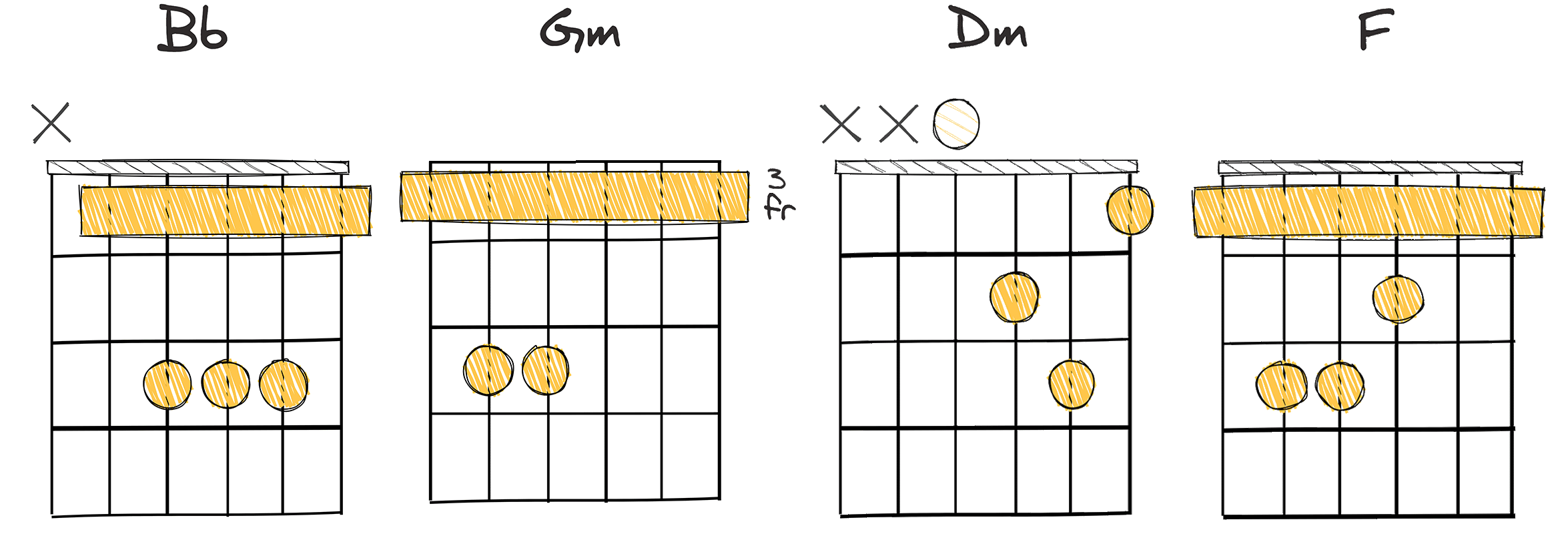
Considering the cornerstones of popular music, I watch our attention fall on chord progressions.
Among the various chord progressions used in romantic numbers, one uniquely unforgettable progression in the world of love songs is the IV-ii-vi-I progression, otherwise expressed numerically as 4-2-6-1.
Historically, this chord progression has been employed by countless artists seeking to evoke powerful romantic sentiments in their ballads and love songs.
Though not as universally acclaimed as some others, this progression, with its rich, emotional tonality, lends itself perfectly to romantic compositions.
It caters to the intention to communicate strong emotions, and as a result, becomes a valued tool in the hands of musicians aiming to create the perfect romantic atmosphere.
In its key of F major, it uses the chords IV (Bb), ii (Gm), vi (Dm), I (F).
The 4-2-6-1 progression in this song conveys different romantic sentiments, from nostalgia to regret and resolution, illustrating the progression’s versatility.
Moving from the IV to the ii chord creates a sense of motion that sets the romantic tone, while the vi chord introduces a deeper, sometimes melancholic twist.
The movement to the I chord delivers a romantic resolution.
Thus, the magnificence of the IV-ii-vi-I chord progression lies in its ability to express the complex layers of emotions associated with love, thereby achieving the goal of every great romantic song.
I-IV-vi-V (1-4-6-5)
A melodically rich progression, crafting an emotional landscape for love.
The I-IV-vi-V progression is an irresistibly sweet and simple chord pattern that bases itself on romantic themes, delivering a tender and emotive sound ideal for the narrative of love songs. By alternating between major and minor chords, this progression creates a poignant, whimsical mood, widely admired for its heartwarming and passionate vibes.
- Difficulty: Easy
- Example: G – C – Em – D (Key of G major)
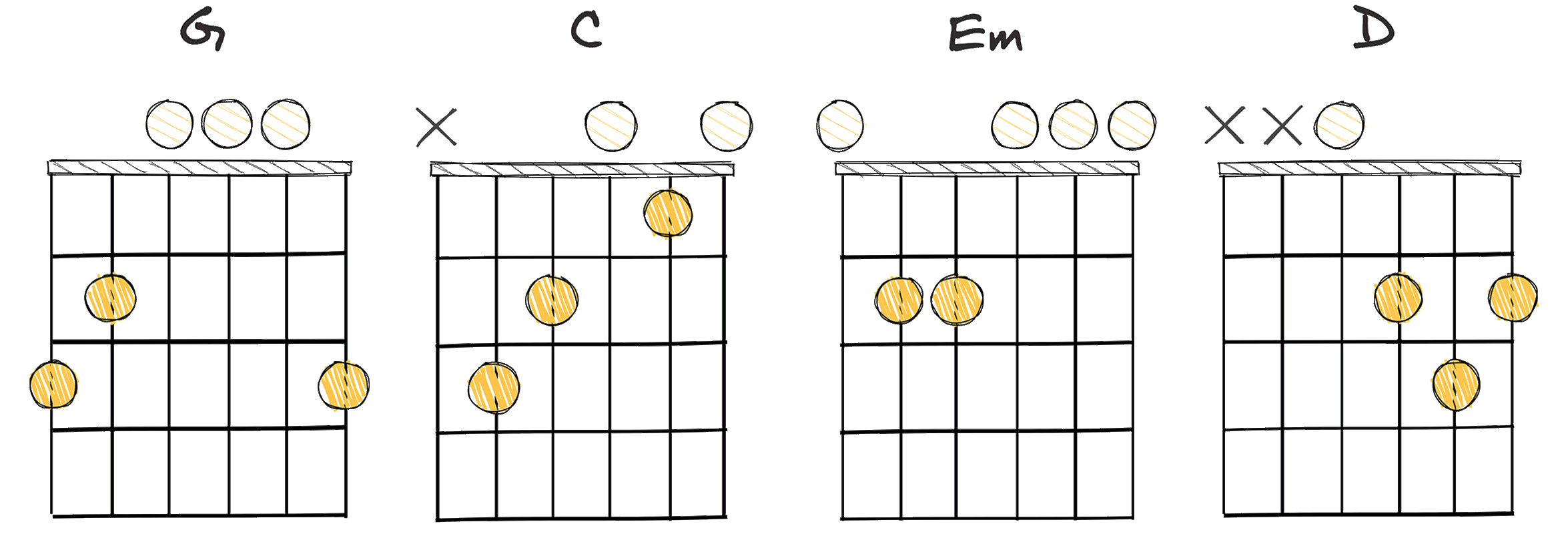
When it comes to creating the perfect love song, the chord progression plays a vital role.
The romantic ambiance and the enticing rhythm can be attributed to particular sequences of chords.
One such melodious chord progression is I-IV-vi-V (1-4-6-5).
This progression has deep historical roots and is a cornerstone in different genres, including pop and classical.
Notably among classics, it remarkably accentuates the romantic elements of a composition.
Indeed, this prgression holds a universal appeal due to its ease of play and the vast range of emotions it can portray.
From melancholy to joy, this progression enables the composition to channel a sweeping range of sentiments.
This simplicity in structure and versatility in emotional depiction makes the 1-4-6-5 progression a popular choice among songwriters and musicians.
In addition to romance, it raises a song’s emotional impact, hence, providing a deeper connection with the listeners.
Even listeners without musical expertise can pick up on these shifts in mood, enhancing their appreciation and enjoyment of the music.
The I-IV-vi-V progression, therefore, carries the romantic undertone beautifully and gives the song ‘the perfect love song’ tag.
Exploring the nuances of these progressions can lead to a deeper understanding of how to create soul-stirring music.
Despite the ease of playing this sequence, it delivers complex emotions effectively.
So, when composing your next love song, do consider the I-IV-vi-V chord progression!
ii-IV-I-V (2-4-1-5)
This progression delivers emotional tenderness ideal for love-themed melodies.
This ii-IV-I-V chord progression, often found in romantic compositions, melodically creates a heart-felt and passionate ambience, perfect for a love song. The oscillation between the secondary and primary chords brings a beautiful sense of resolution and longing, embodying the intricate emotions often associated with romance.
- Difficulty: Easy
- Example: Em – G – D – A (Key of D Major)
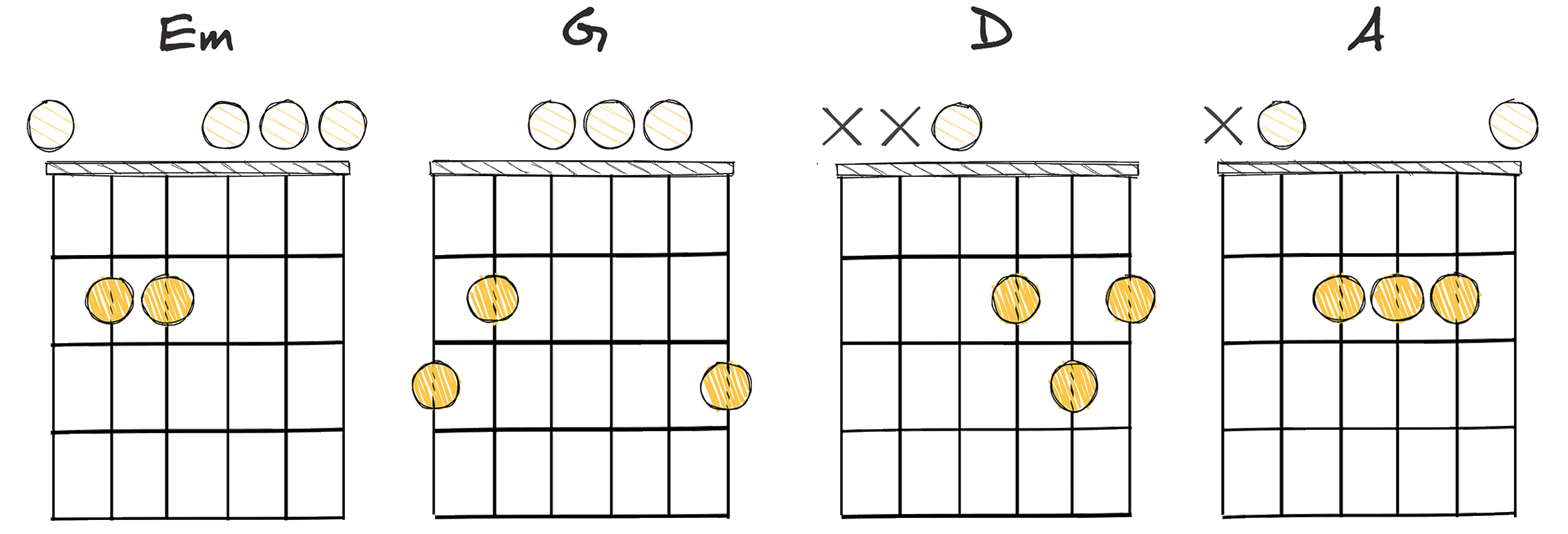
If you’re seeking to add a sprinkle of romance to your musical creations, chord progressions can be a potent tool in your songwriter’s toolbox.
Chord progressions lend their narrative power to songs, weaving tales of passion, loss, and unrequited love.
The ii-IV-I-V (2-4-1-5) is a chord sequence that has been wielded to create countless memorable romantic songs.
As these chords are easy to play, this progression is ubiquitous in the realm of love songs.
Regarded as a classic chord progression, the ii-IV-I-V (2-4-1-5) sequence can be traced back to the 17th century.
Cascading from one chord to the next, this progression has a sense of inevitability and flow, mirroring the dynamics of a romantic relationship.
Indeed, its effectiveness stems from its ability to invoke a profound emotional response — stirring up feelings of longing, nostalgia, and love.
This emotional impact can be attributed to the tension and release mechanism inherent in this progression.
What begins with the minor chord (ii) gradually lifts with the major IV and I chords, before concluding satisfyingly with the dominant V chord.
The ii-IV-I-V progression isn’t exclusive to contemporary pop music.
This timeless melody staple can be traced back to the classical music era, providing a sense of emotional continuity in music history.
Grounded in musical and emotional logic, this progression has an inherent balance.
This balance is beneficial in conveying the intricacies of romantic emotion, avoiding excess sentimentality, yet capable of fully expressing the breadth of love’s joys and sorrows.
The ii-IV-I-V chord progression, while being easy to play, opens up a world of musical possibilities.
With each chord change lies the potential for a shift in mood, creating an emotional journey that listeners can deeply identify with.
Enjoy the simplicity of this progression, and remember that the emotional effectiveness of your music relies on how you utilize these chords, rather than the complexity of the chord structure itself.
Cherish the narrative power of these four chords, as they do not merely accompany the lyrics, but are integral in shaping the emotional landscape of your love song.
Beautiful chord progressions like the ii-IV-I-V are the perfect accompaniment to a love story, adding countless shades of emotion to your music, and immortalizing the roller coaster ride of romance in a melody.
IV-I-IV-V (4-1-4-5)
A dreamy progression often found in timeless love ballads.
The IV-I-IV-V chord progression provides a timeless and romantic feel, often utilized in love songs for its emotive resonance. It starts with the subdominant chord, transitions to the tonic, returns to the subdominant, and finally resolves in the dominant chord, creating a harmonious and poignant sound that perfectly captures the essence of romance.
- Difficulty: Easy
- Example: C – G – C – D (Key of G major)
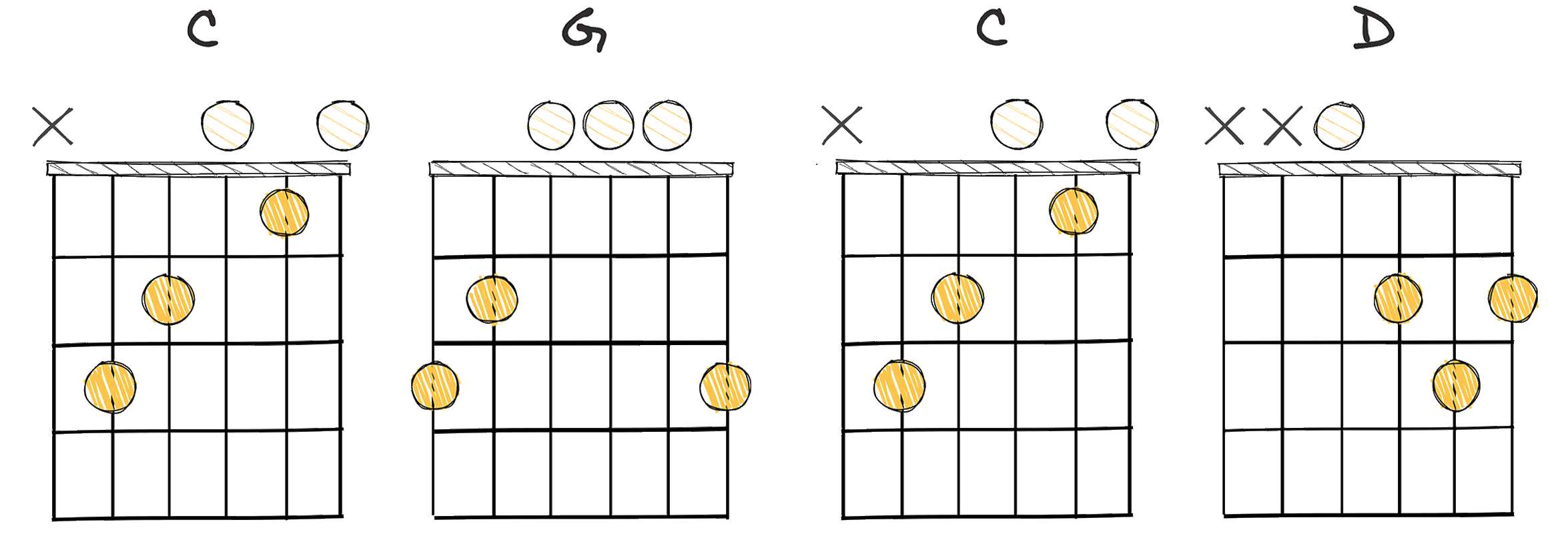
Among the many chord progressions used to create a romantic vibe in songs, the IV-I-IV-V (4-1-4-5) progression holds a special place.
This progression creates a rhythmically interesting and harmonically rich foundation for a song.
Originally, the creation of IV-I-IV-V (4-1-4-5) is surrounded by the influence of blues and rock music.
Its advent brought about a new dimension and intricacy in music that turned out to be crucial for the era.
Over time, this progression found its way into romantic songs creating a solemn and intimate feel, resonating with the listener’s emotions.
It is interesting how this chord progression, rooted in blues, managed to penetrate the romantic genre by enhancing the emotional depth of songs.
The rich and deep tonal qualities of the chords in this progression complements and magnifies the emotional expression in love songs.
This chord progression is easy to play on instruments like guitar or keyboards, thus it’s favored by both novice and seasoned songwriters.
By reflecting the nostalgic mood through these chords, it never fails to capture the listener’s heart driving them into a feeling of longing.
The chords allow the listener to feel the unsaid, igniting a sense of romance and longing within them.
This shows the capacity of the IV-I-IV-V (4-1-4-5) progression to evoke deeper emotions in romantic songs.
Indeed, the incorporation of such a progression into a composition helps to paint a clear picture of the context in the listener’s mind.
I-ii-IV-V (1-2-4-5)
This progression captures the soft radiance of romantic affection.
This classic chord progression, I-ii-IV-V, starts on the home chord and expands toward a sense of tension, before resolving on the dominant. It creates a romantic atmosphere that is commonly used in love songs, providing a solid foundation for memorable melodies and meaningful lyrics.
- Difficulty: Easy
- Example: G – Am – C – D (Key of G major)
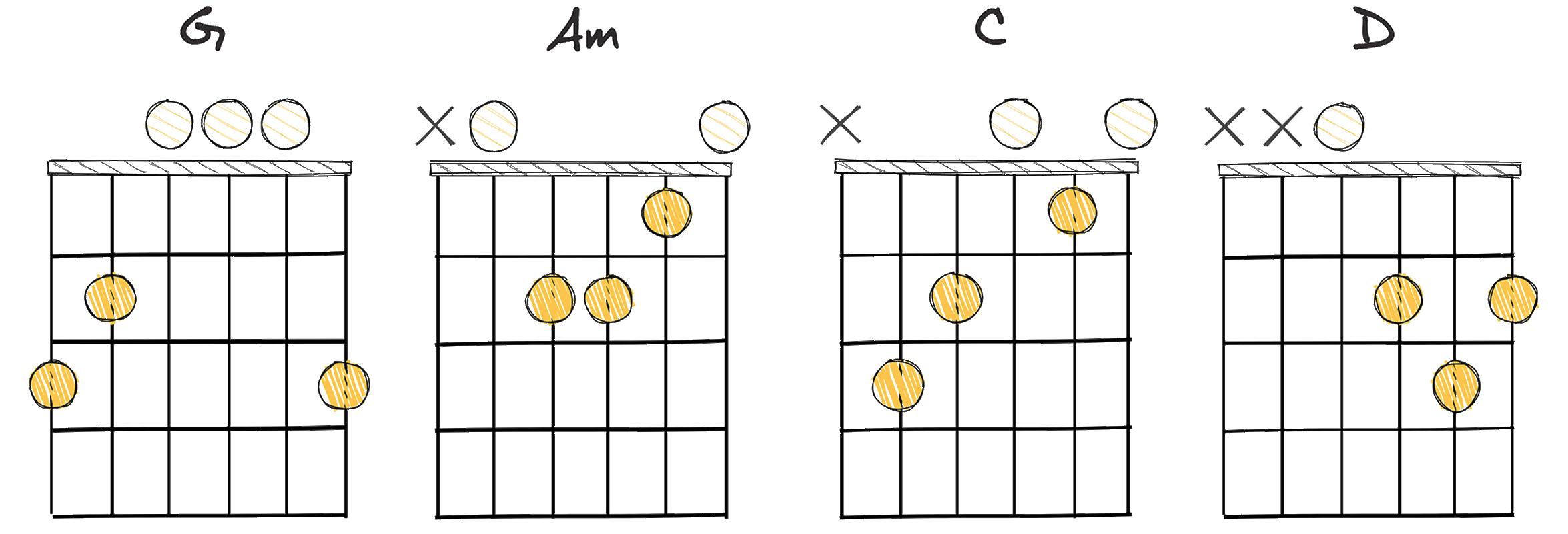
When delving deep into the world of Romantic chord progressions, the combination of I-ii-IV-V (in Roman numerals) or G – Am – C – D (in the key of G major) can be identified as a fantastic starting point.
Historically, this chord progression isn’t new, and its popularity stretches far beyond just love songs.
Rather, the I-ii-IV-V progression can be discovered in a plethora of music genres and has been extensively utilized due to its ability to elicit powerful emotional responses.
This pattern leans into the simple beauty of its cyclic formation, aiding the ease of playability for composers and beginners.
Utilizing a rotational flow, it allows for a remarkable grasp of the song’s essence without sounding repetitive or mundane.
Bearing an edge of the familiar across musical genres, it’s hence versatile while being built on an easy-to-follow structure.
To add dimension to this chord progression, variations such as chord substitutions or alterations can be incorporated.
You could also alter rhythm and pacing to create a different auditory experience.
This further exhibits the flexibility and adaptability of the I-ii-IV-V progression.
Consequently, it can easily be tailored to one’s own musical style and preferences which makes this progression a favorite among musicians.
Its blend of simplicity and adaptability is a surefire way to captivate one’s audience.
vi-ii-IV-V (6-2-4-5)
An enchanting progression, casting a classic fairy-tale romance vibe.
This vi-ii-IV-V progression, also known as 6-2-4-5, provides a romantic and heart-stirring backdrop ideal for a love song. Its movement from minor to major chords creates a beautiful dynamic tension, delivering a deeply emotional feel that captures the ups and downs of love.
- Difficulty: Intermediate
- Example: Am – Dm – F – G (Key of C Major)
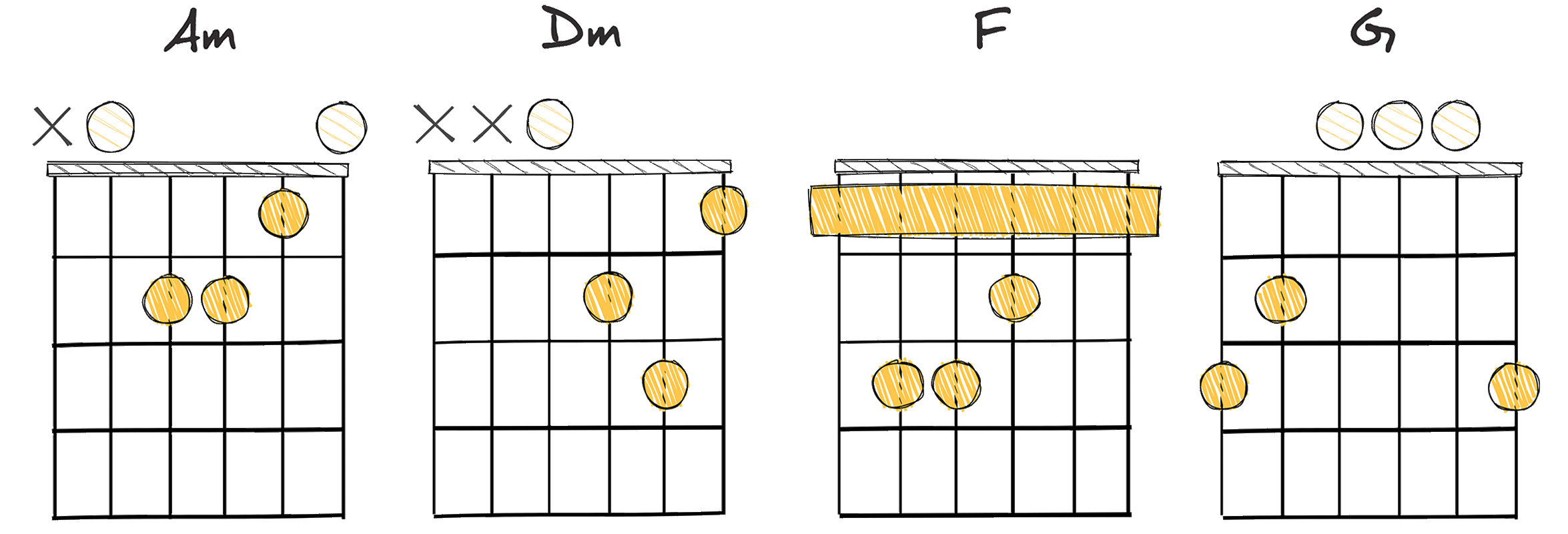
When it comes to composing the ideal love song, choosing the suitable chord progression is crucial.
The vi-ii-IV-V (6-2-4-5) progression is a classic, having found its rightful place in the annals of romantic music.
While many chord progressions have been used with varying success in different genres, the sentimental emotive power of the vi-ii-IV-V cannot be overstated.
It achieves an exquisite balance between melodic invention and familiar harmonic patterns.
The progression holds a strong position in musical history.
It can be traced back to classic songs and has been a prominent feature in pop, rock, and country music, demonstrating its versatility and timeless appeal.
Its prevalence in the realm of Romantic music is particularly notable, having been used by many famed songwriters to articulate feelings of deep affection and longing.
With its roots in classical music, the chord progression carries an inherent sense of structure and resolution.
The climactic shift from the minor vi and major II chords to the dominant IV and V chords creates a narrative of tension and release, mirroring the emotional dynamics of romantic relationships.
As an intermediate chord progression, it may be somewhat challenging to play for some musicians, but it offers a unique avenue for rich musical expression.
The movement from a minor sixth chord to a major second creates a compelling and unpredictable effect, acting like an unexpected twist in a love story.
If one were to map this progression onto the Am – Dm – F – G chords, with the key of C Major, the romantic potential of the progression would be amplified.
Learning to intuitively use the progression can unlock new horizons in songwriting, and it could be just the key you’re looking for to create your own timeless love song.
No matter the genre, this chord progression has proven its worth in countless love songs throughout musical history, making it a trusted tool for any songwriter hoping to express the profoundest emotions of the heart.
IV-vi-V-I (4-6-5-1)
This iconic progression creates an undeniably romantic and timeless sound.
The IV-vi-V-I chord progression fosters a sentimental, heartfelt mood, making it prevalent in romantic and love songs. It typically starts with a warm, comforting tone (IV), evolves into a somewhat melancholic tone (vi), heightens the tension (V), and finally resolves beautifully (I), creating a deeply emotional sonic journey.
- Difficulty: Intermediate
- Example: C – Em – D – G (Key of G major)
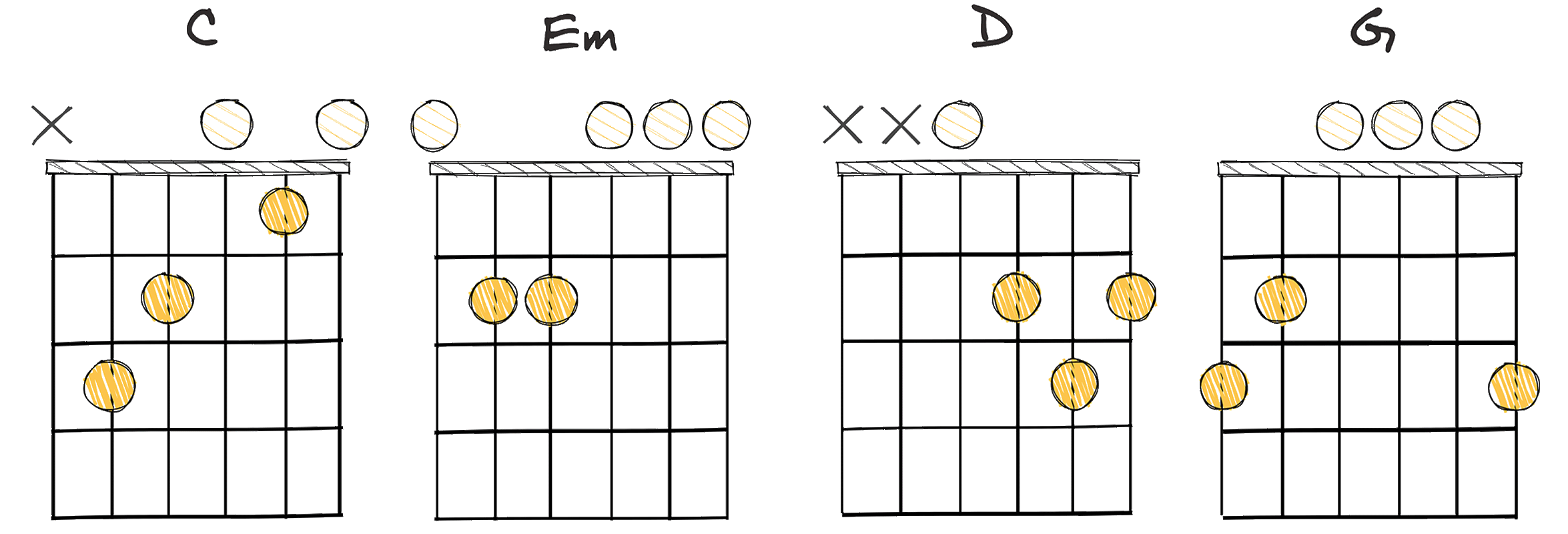
One of the enchanting aspects of music and songwriting lies in the infinite possibilities of combining chords.
When looking to evoke a certain mood, like that of love and romance, chord progression has proven to be greatly influential.
An interesting chord progression that exudes a romantic aura is the IV-vi-V-I (4-6-5-1) progression.
This progression is not beginner-friendly and is more suited for intermediate players, due to its inherent complexity.
Fortunately, with some practice and understanding of music theory, it should become more comfortable to play.
The IV-vi-V-I progression has been typically associated with a somber and passionate romantic theme that can easily tug at the heartstrings.
It employs the 4th (subdominant), 6th (submediant), 5th (dominant), and the 1st (tonic) notes of the musical scale, in that order.
Rich with musical tension and resolution, it allows for a dramatic experience that can be found in many romantic melodies.
History shows us that this progression has been used in countless songs across a myriad of genres, especially in love songs.
Therefore, experimenting with and mastering the IV-vi-V-I progression could dramatically enhance your love song compositions.
This progression, while requiring a certain level of expertise, rewards the effort with a tune that inherently speaks the language of love.
I-IV-I-V (1-4-1-5)
A quintessential chord journey evoking classic, heart-warming affection.
The I-IV-I-V progression is a timeless sequence that has been used extensively in the creation of classic love songs due to its evocative and romantic feel. Its chord transitions provide a powerful, yet gentle tension and resolution, capable of conveying deep emotional experiences.
- Difficulty: Easy
- Example: G – C – G – D (Key of G major)
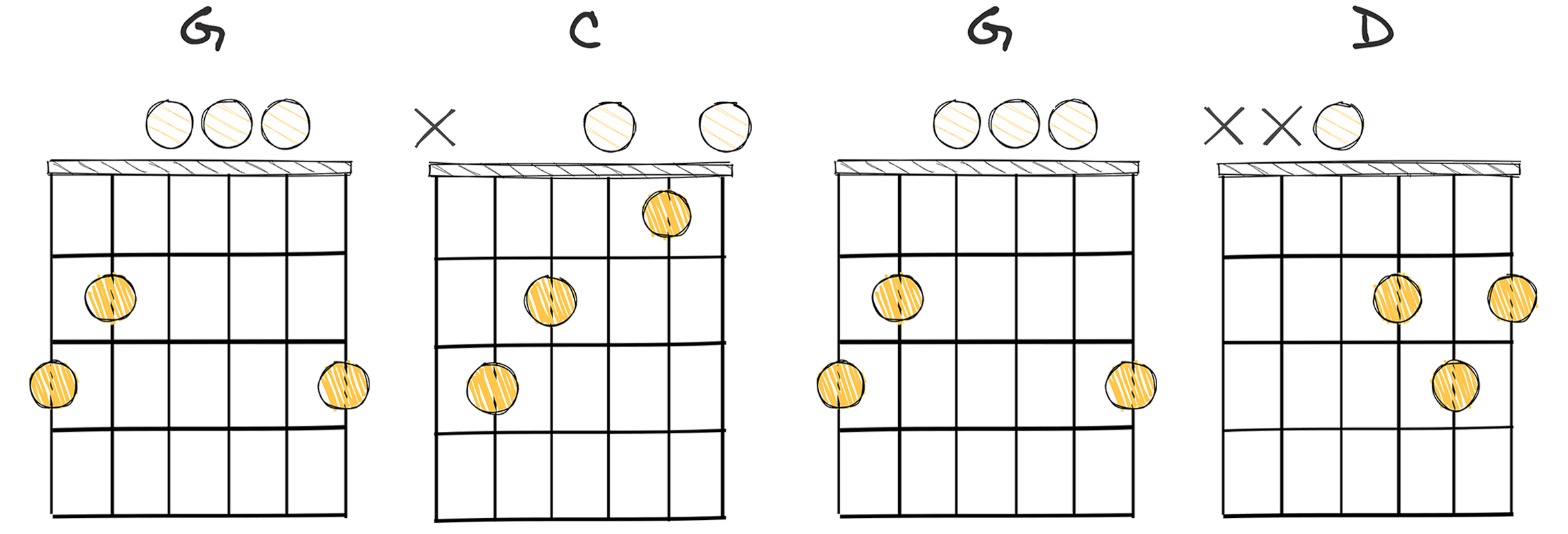
The I-IV-I-V chord progression, in the realm of romantic chord progressions for the perfect love song, retains a special significance.
This chord progression, situated in the key of G major, translates as G – C – G – D, and is often favored by musicians for its simplicity and ease of use.
This is a rather accessible progression, especially for beginners, due to its simplistic structure and easy-to-play chords.
It’s a progression that opens room for personal creativity while also retaining an inherent romantic resonance.
The III, for instance, is notably absent, which allows for the chord progression to have a smoother, more endearing sound.
This kind of progression, therefore, allows for a more engaging and heartfelt song outcome.
The “I-IV-I-V” progression is therefore favored not only for its romantic tone, but for the flexibility and simplicity it provides for songwriters and musicians.
In the realm of music history, this particularly charming progression has long been utilized for its engaging and heart-rendering qualities.
It has often been the progression of choice for many well-loved and classic love songs.
As such, understating the inherent beauty and creative power of the I-IV-I-V progression is not merely about memorizing chords— it’s also about understanding how its arrangement can unlock a world of emotive musical storytelling.
And though it may seem deceptively simple, the I-IV-I-V progression’s unassuming facade reveals the rich creative potential that lies beneath.
This progression thus invites musicians and songwriters, regardless of their experience level, to tap into the heart of their own unique romantic song.
In essence, the I-IV-I-V chord progression shares a timeless story of romance and emotional depth, making it an ideal foundation for any love song.
The Bottom Line
Following a comprehensive examination of various chord progressions such as I-V-vi-IV (1-5-6-4), II-V-I (2-5-1), IV-V-iii-vi-ii (4-5-3-6-2), IV-ii-vi-I (4-2-6-1) and others, it is evident that they carry distinct sounds and evocative potentials.
These progressions form the backbone of countless songs across numerous genres, and their popularity with composers is testament to their musicality and versatility.
Although the precise emotional impact may vary depending on other musical elements like rhythm, tempo, and instrumentation, the foundation remains rooted in these ubiquitous chord patterns.
As such, a deep understanding and practical command of these progressions can significantly enhance a musician’s songwriting and compositional skill set.
In love with guitars, and gear; expert in all things music! Been writing about guitars for about 5 years and counting. Born in the ’90s. Alma Mater: University of Havana. Always curious, trying to understand the world. #TeamFender




